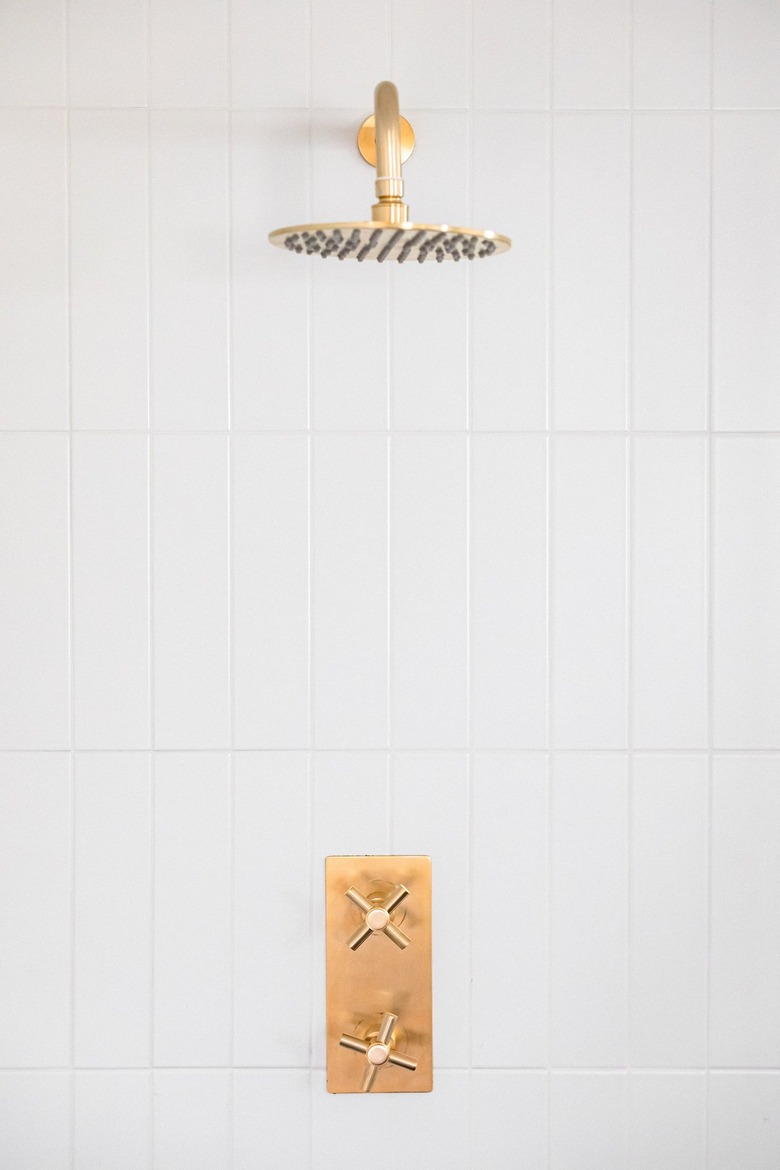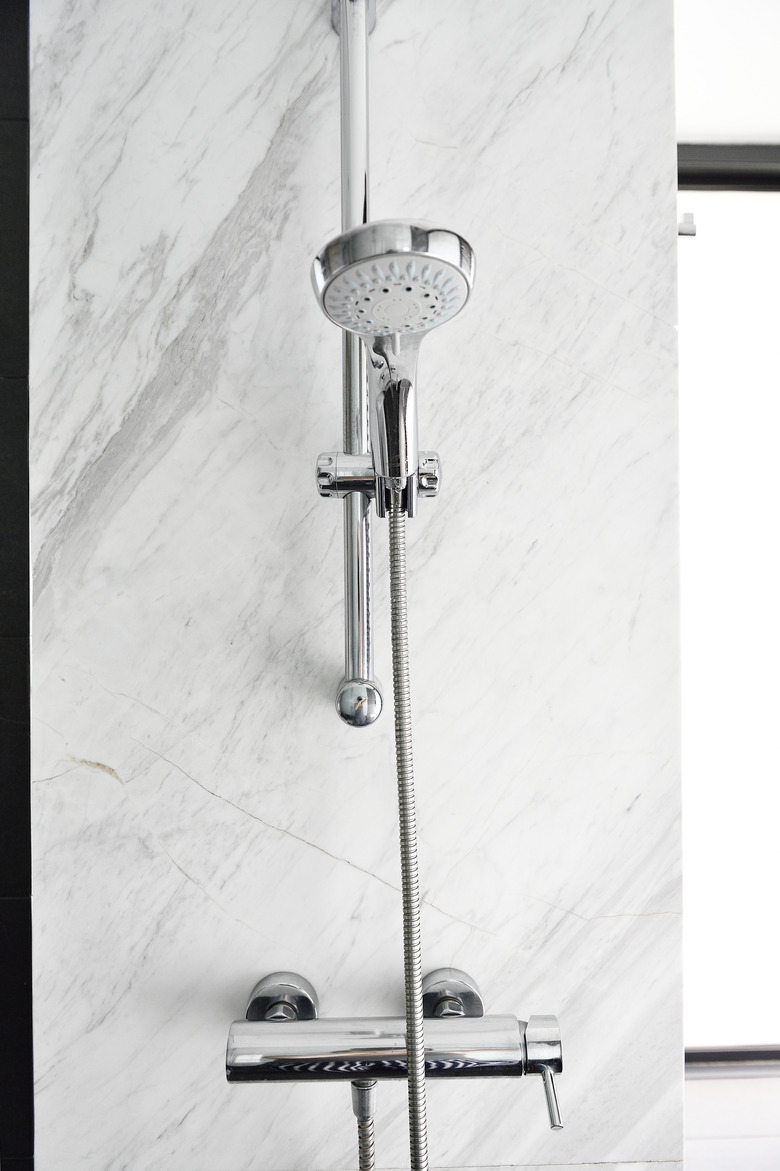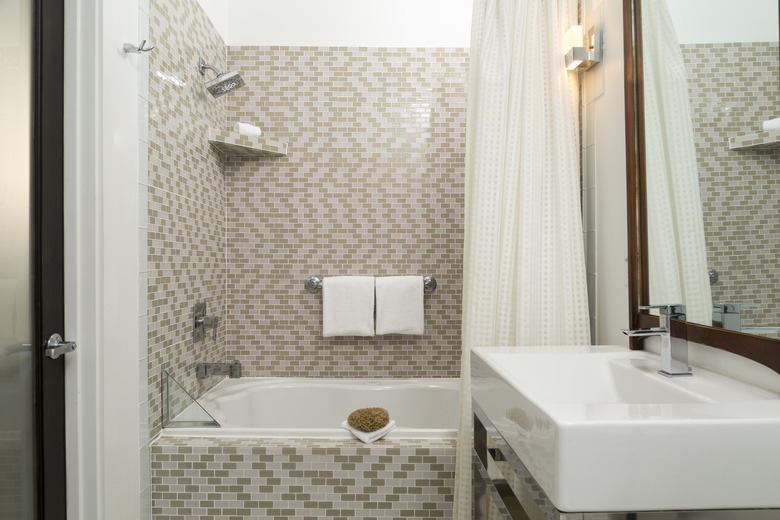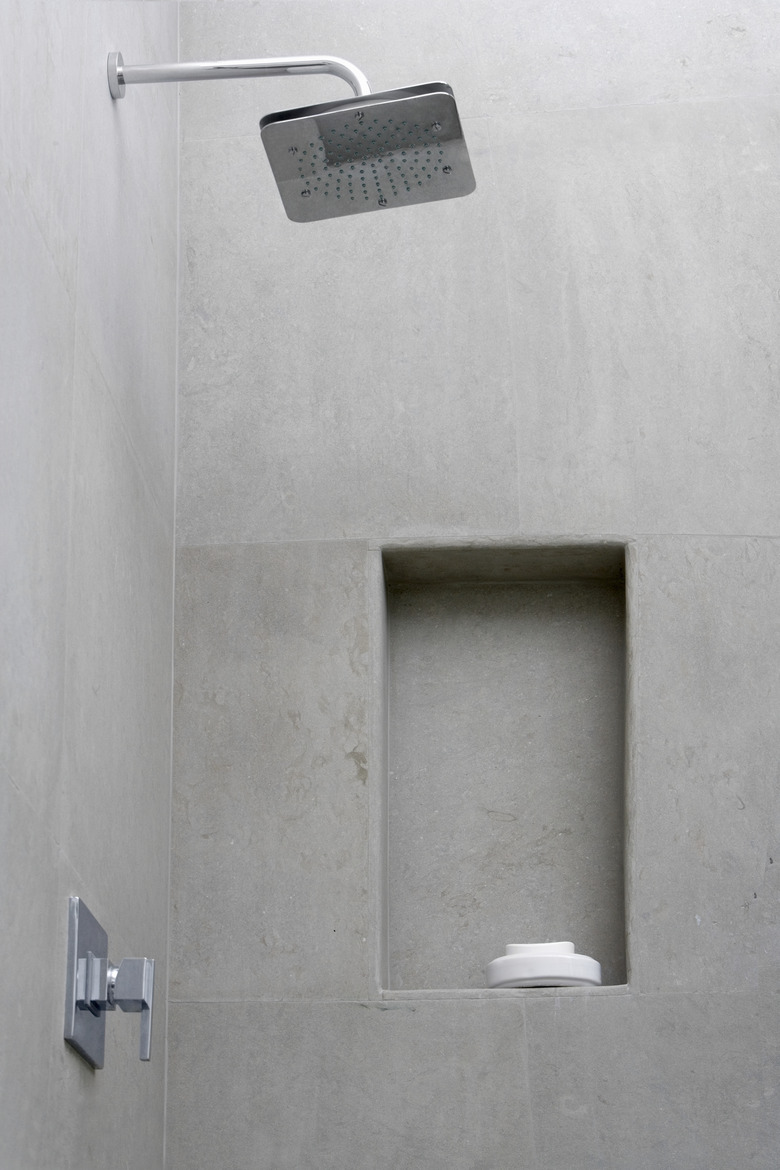How To Fix A Leaky Showerhead
We may receive a commission on purchases made from links.
When a showerhead is described as being leaky, it can mean several different things. For example, it might mean that water dribbles out around the joint where the showerhead attaches to the angle shower arm that comes out of the wall, or it could mean that a small amount of water continues to drip out of the showerhead even when the shower valve is turned off. In some cases, you won't really see any leaking from the showerhead itself because the leak is occurring back inside the wall, where the water can wreak some really serious havoc.
Some of the solutions to a leaky showerhead are very simple, while others are considerably more complicated. The first step is to diagnose the cause of a leaky showerhead. This generally requires only careful observation of the behavior of your shower valve and showerhead.
Diagnosing a Leaky Showerhead
Diagnosing a Leaky Showerhead
Determining the cause of the leaky showerhead is usually quite easy, and it can be done by observing the shower when the faucet is both on and off. If you have a tub/shower combination, many problems originate with the diverter valve that shifts the flow of water back and forth from the tub spout to the showerhead. Watching the shower as you shift the diverter valve will help identify if the problem lies with the diverter valve.
Diagnosing a Leaky Showerhead Chart
Diagnosing a Leaky Showerhead Chart
|
Symptom |
Cause |
Solutions |
|
Showerhead dribbles water even when faucet is off |
Faulty valve cartridge |
Replace valve cartridge |
|
When faucet is on, leaking occurs at joint between showerhead and shower arm |
Faulty seal on shower arm |
Reseal threads of the shower arm |
|
Tub spout dribbles; insufficient flow to showerhead |
Faulty diverter valve |
Replace tub spout; repair diverter valve |
|
Shower arm leaks inside the wall |
Faulty seal on drop-ear elbow or broken shower arm |
Reseal threads of shower arm; replace shower arm |
|
Water dribbles rather than sprays from showerhead |
Showerhead clogged with sediment or has mineral scale buildup |
Clean showerhead; replace showerhead |
The materials for fixing leaky showerheads are fairly basic supplies that you can buy at any hardware store or home center, or likely, even things you already have around the house. After diagnosing the cause of the problem based on the symptoms, read these repair instructions and gather the tools and materials that are required for your repair.
Replacing a Shower Valve Cartridge
Replacing a Shower Valve Cartridge
If your showerhead and/or tub spout is dribbling water even when the shower valve is in the off position, it is almost certain that the problem lies with the internal cartridge for the shower valve. When the rubber or neoprene seals inside the cartridge become worn or cracked, they can allow a small amount of water to flow on through the valve and out the showerhead. While some cartridges can be reconditioned by replacing only the rubber seals, the more common solution is to replace the entire cartridge.
Most shower faucet manufacturers, such as Moen, strongly suggest that you use only original equipment manufacturer cartridges since they are precisely designed to fit the specifications of your faucet. Finding the right cartridge is easiest if you have the model number of the faucet, but Moen and other manufacturers also have methods for identifying the faucet model from visual cues.
The procedure for replacing the valve cartridge varies depending on the manufacturer, but the general procedure is to:
- Turn off the water supply to the faucet.
- Remove the faucet handle and remove the escutcheon cover plate on the faucet valve.
- Loosen whatever retaining ring or mounting ring is present to secure the valve cartridge in place.
- Extract the old, worn cartridge from the body of the faucet. The method for doing this varies according to the faucet style.
- Install a new exact-duplicate cartridge, making sure to align it correctly within the faucet body.
- Reattach the retaining ring that secures the cartridge.
- Adjust the temperature control feature on the new faucet as specified by the manufacturer.
- Reattach the cover plate and handle, turn on the water and test the faucet.
Resealing a Shower Arm
Resealing a Shower Arm
If, when the faucet valve is turned on, water dribbles out around the joint where the showerhead is threaded onto the angled arm that comes out of the wall, then the solution is usually a simple matter of resealing the shower arm joint.
- Wrap a cloth around the showerhead to prevent scratches and then unscrew the showerhead from the shower arm using tongue-and-groove pliers.
- Thoroughly clean the threads on the shower arm using a clean rag or small brush. Make sure the threads are clean and in good condition.
- Wrap several loops of plumbers' thread-seal tape around the threads of the shower arm in a clockwise motion.
- Screw the showerhead back onto the shower arm using tongue-and-groove pliers. Again, wrap the showerhead with a cloth to prevent scratching and make sure not to overtighten and damage the shower arm.
On old showers, the threads of the shower arm may be badly corroded. In this case, the best repair is to replace the shower arm entirely.
Replacing a Tub Spout
Replacing a Tub Spout
In a tub/shower combination, if water continues to dribble out the spout without the full stream flowing up to the showerhead, the problem almost certainly lies with the diverter valve. In many showers, the diverter is a simple gate valve on the tub spout, which you operate by pulling or pushing the handle. You can check its operation by operating the handle while the faucet is fully on. If the water is not fully diverted up to the showerhead, it means the valve is faulty.
Sometimes, a simple spray of lubricating oil will cause this kind of gate diverter to return to good operation, but more often, you will need to replace the old spout with a new one. Fortunately, this is quite an easy replacement. Some tub spouts are screwed onto a threaded adapter at the end of the water stubout pipe; others are secured in place with a setscrew that operates with a hex wrench or screw.
- Look for a small cap on the side of the tub spout near the point where it touches the wall. If present, remove this cap to expose the setscrew. Loosen the screw using an Allen wrench or screwdriver and then remove the tub spout.
- If no setscrew is present, the spout is a threaded model. Use tongue-and-groove pliers to twist the tub spout in a counterclockwise direction to unscrew it from the stubout pipe.
- Buy a duplicate spout that matches the size and configuration of the old one.
- If the tub is a threaded model, wrap the threads on the stubout pipe with several loops of plumbers' thread-seal tape.
- Slide or screw the new spout onto the stubout pipe. For screw models, use a cloth to protect the finish on the spout as you screw it onto the pipe. For setscrew types, tighten the setscrew to secure.
- Turn on the water and test the diverter. If necessary, caulk around the spout where it touches the wall.
Repairing a Diverter Valve
Repairing a Diverter Valve
On some tub/shower combinations, the diverter valve that shifts water back and forth between the tub spout and showerhead is operated by a third handle mounted in the wall between the hot and cold faucet handles. These diverters are usually an easy matter to fix by replacing the valve stem in the diverter. While it is sometimes possible to fix them by simply replacing a washer or seal at the end of the stem, the more common repair is to simply replace the entire stem with a new one designed for your faucet model.
- Turn off the water supply to the tub/shower faucet.
- Pop the cap off the diverter handle, exposing the mounting screw. Remove the mounting screw and pull the diverter handle off the stem.
- If possible, remove the escutcheon plate that covers the base of the diverter where it enters the wall. This is not always possible.
- If there is a protective sleeve present around the diverter stem, remove it.
- Using a deep-set socket, unscrew the diverter stem from the body of the faucet. There may be a nylon washer around the end of the stem; make sure this comes off as well.
- Buy and install a new diverter stem, threading it into place using the deep-set socket.
- Reassemble the escutcheon plate and handle on the diverter.
- Turn on the water and test the operation of the diverter valve.
Replacing a Shower Arm
Replacing a Shower Arm
Several symptoms can indicate that you need to replace the angled shower arm that links the showerhead to the stand pipe inside the wall. When unscrewing the showerhead from the wall, if you notice that the threads on the shower arm are corroded or in otherwise bad condition, the best solution is to replace the shower arm as part of the overall repair.
More seriously, if water is leaking inside the wall, it's likely that there is a crack in the shower arm or a bad connection at the threaded portion of the arm where it attaches to the threaded elbow (known as a drop-ear 90-degree elbow) inside the wall. This elbow is the point where the shower arm turns downward to the vertical pipe leading to the faucet. If a leak develops at this point, you may notice water draining inside the wall to the floor below, or you may notice that moisture inside the wall has caused loosened tiles or other damage to the wall surface.
This is quite a serious problem that may require structural repairs or replacing wall materials. If you are lucky and catch the problem early, you may be able to get by with simply replacing the shower arm.
- Turn off the water supply to the shower.
- Unscrew the showerhead from the shower arm using tongue-and-groove pliers. If you plan to reuse the showerhead, wrap it with a cloth to prevent the tool from scratching the finish as you unscrew it.
- Remove the escutcheon plate that covers the area where the shower arm enters the wall. In most cases, the plate will simply slide off the shower arm. You may need to cut away a caulk bead to free it from the wall.
- Carefully unscrew the shower arm from the threaded drop-ear elbow inside the wall. Be cautious about this, as the goal is to remove the shower arm intact without breaking it off. If the pipe comes out intact, then skip to step eight.
- If the shower arm breaks off as you remove it (this is common with old materials), then use an expandable pipe extractor to remove the remaining piece of pipe. Select the pipe extractor fitting that matches the size of the shower arm pipe and insert it into the remaining piece of pipe that is still threaded into the elbow.
- Tighten the center bolt of the pipe extractor tool in a clockwise direction with an adjustable wrench. As you do this, inner teeth on the extractor will expand to grip the inside of the pipe.
- When the extractor has a tight grip on the pipe, use the adjustable wrench to twist the base of the extractor in a counterclockwise direction. The tool will unscrew the remaining portion of the shower arm out of the threaded elbow fitting.
- Wrap thread-seal tape around the threads of a new shower arm and thread it by hand into the elbow fitting inside the wall. Wrap the arm with a rag to protect the finish and then tighten it with tongue-and-groove pliers. Make sure the angle on the arm points downward.
- Replace the escutcheon plate and showerhead and then turn on the water.
Cleaning a Showerhead
Cleaning a Showerhead
If water dribbles out of a showerhead rather than emerging with clear jets of spray, it is likely that mineral particles or scale have built up inside the showerhead, partially blocking the holes. The answer is usually to simply clean the showerhead. Some showerheads can be disassembled to make cleaning easier, but with cheaper models, this may not be possible.
- Wrap the showerhead with a cloth to protect the finish and then unscrew it from the shower arm.
- If possible, disassemble the showerhead and use a small scrub brush to remove any visible particles from the parts.
- Place the showerhead (or disassembled parts) into a small bucket or plastic bag filled with white vinegar or a lime-dissolving solution, such as Lime-A-Way. Let it sit for several hours or overnight until the scale buildup has been dissolved.
- Rinse the parts with clear water and then reassemble the showerhead.
- Clean the threads on the shower arm and wrap it with several loops of new thread-seal tape. Then, screw the showerhead back onto the arm.
- Turn on the water and test the operation of the showerhead. If the showerhead continues to dribble rather than spray, it means the showerhead is beyond repair. Purchase and install a new showerhead.



